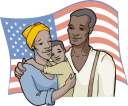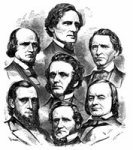
Worksheets and No Prep Teaching Resources
Reading Comprehension Worksheets
Black History and Blacks in U.S. History
A Nation Divided
(1840-1861)

Black History and Blacks in U.S. History
 Worksheets and No Prep Teaching Resources Reading Comprehension Worksheets Black History and Blacks in U.S. History A Nation Divided (1840-1861) |
 Black History and Blacks in U.S. History |
| edHelper's suggested reading level: | grades 7 to 8 | |
| Flesch-Kincaid grade level: | 7.07 |
|
Slave Economy
By Mary L. Bushong |

|
 1 Slavery has been a fact of life throughout history, and no race has been left untouched by its shackles. When the colonies were first being settled, labor was hard to come by, and it was procured any way possible. For some, it was through indentured servitude. For others, it was through slavery.
1 Slavery has been a fact of life throughout history, and no race has been left untouched by its shackles. When the colonies were first being settled, labor was hard to come by, and it was procured any way possible. For some, it was through indentured servitude. For others, it was through slavery. |
Create Weekly Reading Books
Prepare for an entire week at once! |
| Leave your feedback on Slave Economy (use this link if you found an error in the story) |
 |
Black History and Blacks in U.S. History
|
 |
A Nation Divided (1840-1861) |
 |
United States
|
|
|
 | Fifty States Theme Unit |
 |
Document Based Activities |